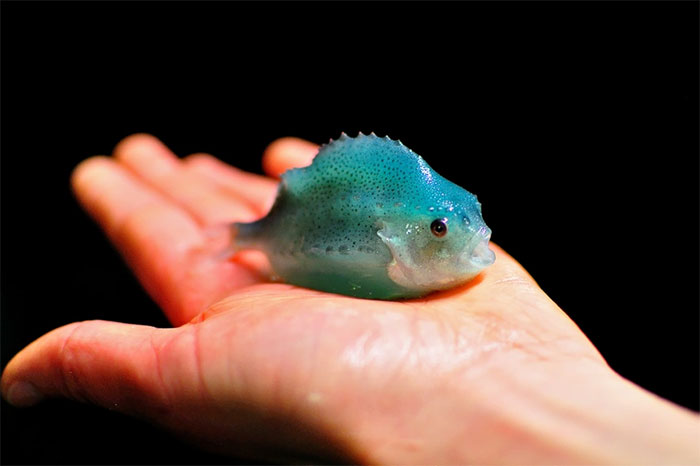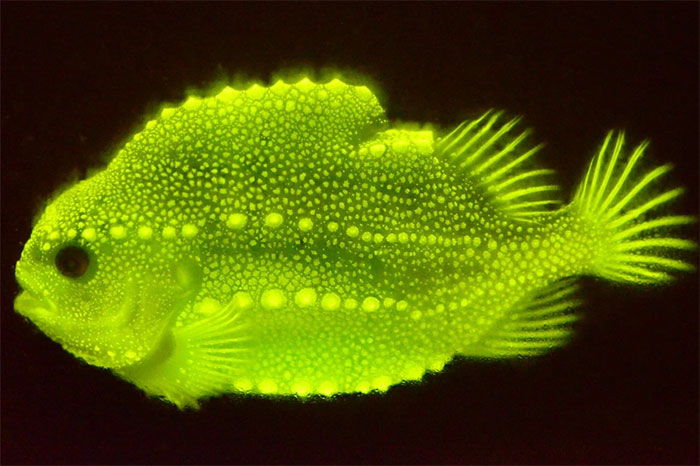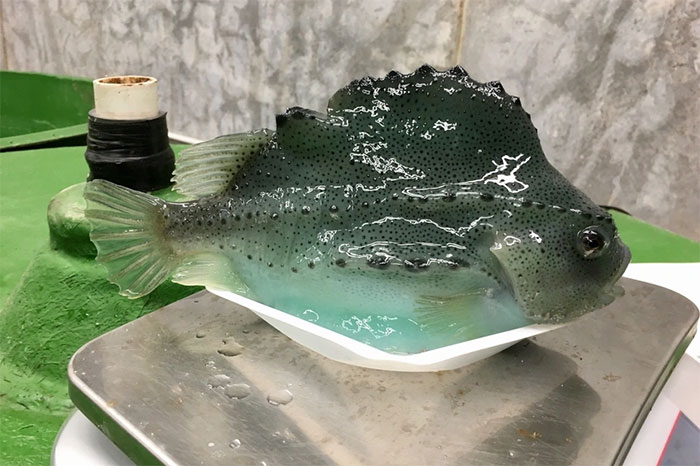Scientists have discovered the unique characteristics of the lumpfish, a species that inhabits the seafloor near the shores of various regions in the North Atlantic and Arctic Oceans.
If you ask the question: “What color is the lumpfish?”, you will receive many different answers.
This species changes color over time, and at each age, they exhibit a specific coloration. However, recent research suggests that scientists believe they have identified the true color of these fish – it is fluorescent green.

Lumpfish look quite amusing and are often raised in salmon farms as they eat sea lice, helping to clean the salmon’s habitat. (Photo: Reddit/u/NinjaKamihana).
Famous for TikTok
In a study published this month in the Journal of Fish Biology, the authors reported that lumpfish glow when placed under UV light.
They believe that this species uses their bioluminescent radiation to recognize and communicate with each other.
In recent years, researchers have discovered many animal species with bioluminescent capabilities, including catsharks, opossums, flying squirrels, and platypuses. The lumpfish is the latest addition to this list.
The lumpfish, scientifically known as Cyclopterus lumpus, is a solitary species that spends most of its life on the ocean floor. They have the ability to attach their belly to surfaces such as rocks or seaweed. This body structure has evolved from their pelvic fins and functions like a suction cup.
With a rather amusing facial expression, lumpfish have also gained popularity on social media platforms like TikTok, with thousands of videos of this fish recorded by researchers or fishermen.
“This is quite a peculiar fish,” Nathaniel Spada, a research assistant at the Woods Hole Oceanographic Institution in Massachusetts, shared. Although he was not involved in the study, his videos of lumpfish have garnered millions of views on TikTok.
“I didn’t think they (the lumpfish videos) would become so popular, but I should have anticipated it because they are truly fascinating fish,” Spada added.
Last year, Thomas Juhasz-Dora, a veterinarian pursuing a PhD at University College Cork in Ireland, became curious when he looked into the bulging eyes of a juvenile lumpfish in the lab. He suddenly had an idea.
Having witnessed bioluminescence in some marine organisms, Juhasz-Dora wanted to know if lumpfish possessed this trait. He collected 11 juvenile lumpfish and photographed them under different lighting conditions.
Under normal light, lumpfish appear blue mixed with green like a sponge. But when exposed to UV light, their entire body emits a neon blue glow.

Lumpfish emit a strong neon blue color under UV light. (Photo: Thomas Juhasz-Dora).
“I felt like ‘Wow’,” Dr. Juhasz-Dora shared. He was amazed by the strong fluorescence of the lumpfish. This phenomenon occurs when certain organisms absorb ultraviolet (UV) light, which is invisible to the naked eye, and re-emit it as a color visible to us, typically red, orange, or green.
This is different from bioluminescence, where an organism generates light through chemical reactions within its body.
A Colorful Fish
Many animal species possess special filters in their corneas, allowing them to see bioluminescence without the aid of UV light.
Dr. Juhasz-Dora hypothesizes that lumpfish may also have such filters, enabling them to somehow signal to communicate with their peers while remaining hidden from predators.
According to Elizabeth Fairchild, a researcher and associate professor at the University of New Hampshire specializing in lumpfish and various other seafood, Juhasz-Dora’s hypothesis is entirely plausible.
Lumpfish may also use their bioluminescent abilities to attract prey. However, Dr. Fairchild believes it is more likely that they use this tool for communication.
“Communication is probably the most plausible answer. It’s just that we don’t know what they are communicating,” Fairchild said.
It is also possible that bioluminescence serves no specific purpose. However, Dr. Fairchild, who was not involved in the study, believes this is unlikely due to the importance of coloration for lumpfish.
“Lumpfish have an impressive ability to change color. When they are young, they can display every color of the rainbow. As they grow a bit older, they can change their skin color based on their surroundings, helping them hide from predators,” Fairchild explained.
“By the time they reach adulthood, lumpfish change their skin color from light gray to pale green. However, during the breeding season, they change color again, with males turning orange-red and females becoming blue,” the doctor added.

An adult lumpfish. (Photo: University of Maine).
How and why the bioluminescent ability appeared in lumpfish is one of many questions raised by Dr. Juhasz-Dora’s discovery. He and his colleagues are currently researching whether this fish can control its fluorescence or if it is entirely passive.
According to Dr. Juhasz-Dora, his discovery and that of his colleagues have “opened the door to new explorations.”
“It allows us to see the world from their (the lumpfish’s) perspective, rather than our own,” he said.


















































